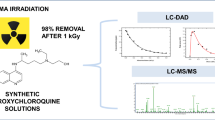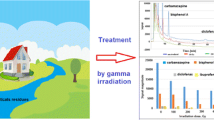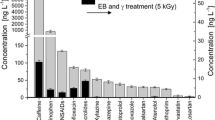Abstract
The effectiveness of radiolytic decomposition of widely used organophosphorus pesticide chlorfenvinphos using γ-irradiation from 60Co source was investigated using HPLC and ion-chromatography for monitoring of decomposition products. In terms of irradiation dose the Microtox toxicity of irradiated solutions was examined, and also effect of irradiation on ability of irradiated chlorfenvinphos solutions to inhibit activity of enzyme acetylcholi-nesterase was investigated.







Similar content being viewed by others
References
Hallab AH (1968) Detoxification of pesticidal residues in fish and shell-fish. Diss Abstr 29:649
Peller J, Wiest O, Kamat PV (2004) Hydroxyl radical’s role in the remediation of a common herbicide 2,4-dichloorophenoxyacetic acid (2,4-D). J Phys Chem A 108:10925–10933
Peller J, Kamat PV (2005) Radiolytic transformations of chlorinated phenols and chlorinated phenoxyacertic acids. J Phys Chem A 109:9528–9535
Zona R, Solar S, Gehringer P (2002) Degradation of 2,4-dichlorophenoxyacetic acid by ionizing radiation: influence of oxygen. Wat Res 36:1369–1375
Zona R, Solar S (2003) Oxidation of 2,4-dichlorophenoxyacetic acid by ionizing radiation: degradation, detoxification and mineralization. Radiat Phys chem 66:137–143
Liu SY, Chen YP, Yu HQ, Zhang SJ (2005) Kinetics and mechanisms of radiation-induced degradation of acetochlor. Chemosphere 59:13–19
Abel Aal SE, Dessouki AM, Sokker HH (2001) Degradation of some pesticides in aqueos solutions by electron beam and gamma-radiation. J Radioanal Nucl Chem 250:329–334
Drzewicz P, Trojanowicz M, Zona R, Solar S, Geringer P (2004) Decomposition of 2,4-dichlorophenoxyacetic acid by ozonation, ionizing radiation as well as ozonation combined with ionizing radiation. Radiat Phys chem 69:281–287
Drzewicz P, Gehringer P, Bojanowska-Czajka A, Zona R, Solar S, Nałęcz-Jawecki G, Sawicki J, Trojanowicz M (2005) Radiolytic degradation of herbicide dicamba for environmental protection. Arch Environ Cont Toxicol 4:311–322
Bojanowska-Czajka A, Drzewicz P, Kozyra C, Nałęcz-Jawecki G, Sawicki J, Szostek B, Trojanowicz M (2006) Radiolytic degradation of herbicide (4-chloro-2-metylphenoxy) acetic acid (MCPA) by γ radiation for environmental purposes. Ecotox Env Safety 65:265–277
Bojanowska-Czajka A, Drzewicz P, Zimek Z, Nichipor H, Nałęcz-Jawecki G, Sawicki J, Kozyra C, Trojanowicz M (2007) Radiolytic degradation of pesticides 4-chloro-2-methylphenoxyacetic acid (MCPA)—experimental data and kinetic modeling. Radiat Phys chem 76:1806–1814
Galloway TR, Handy R (2003) Immunotoxicity of organophosphorous pesticides. Ecotoxicology 12:345–363
Grant DL, Sherwood CR, KAm McCully (1969) Degradation and anticarboxylesterases activity of disulfoton and phorate after 60Co gamma irradiation. J Assoc Off Anal Chem 52:805–811
Lippold PC, Cleere JS, LMJr Massay, Bourke JB, Avens AW (1969) Degradation of insecticides by Cobalt-60 gamma radiation. J Econ Entomol 62:1509–1510
Cappadona C, Guarino P, Calderaro E, Petruso S, Ardica S (1975) Possible use of high-level radiation for the degradation of some substances present in urban and industrial waters. Radiat Clean Environ Proc Int Symp 265–284
Cogburn RR, Mahany PG (1969) Effect of gamma irradiation on the insecticidal efficiency of malathion deposits on wheat and kraft paper. J Econ Entomol 62:829–831
Aguila A, O’Shea KE, Tobien T, Asmus KD (2001) Reactions of hydroxyl radical with dimethylphosphonate and diethyl methylphosphonate. A fundamental mechanistic study. J Phys Chem A 105:7834–7839
Basfar AA, Mohammed KA, Al-Abduly AJ, Al-Kuraiji TS, Al-Shahrani AA (2007) Degradation of diazinon contaminated waters by ionizing radiation. Radiat Phys chem 76:1474–1479
Benon KI, Davies L, Elgar K (1966) Analysis of propos and soils for residues of diethyl 1-(2,4-dichlorophenyl)-2-chlorovinyl phosphate. I. Development of method. J Sci Food Agric 17:162–167
Wiliams JH (1975) Persistence of chlorfenvinphos in soils. Pestic Sci 6:501–509
Tomlin C (1994) A world compendium. The pesticide manual. Incorporating the agrochemicals handbook, CDS Tomlin. British Crop protection Council, Bungay, Suffolk
Fontana E, Pianezzola E, Basileo G, Strolin M, Benedetti L (1993) High-performance liquid chromatogarphic determination of FCE 24928, a new aromatase inhibitor, in human plasma. J Chromatogr A 655:293–298
Leoni V, Caricchia AM, Chiavarini S (1992) Multiresidue method for quantitation of organophosphorus pesticides in vegetable and animal foods. J Assoc Off Anal Chem Int 75:511–518
Gałęzowska A, Sikora T, Istamboulie G, Trojanowicz M, Połeć I, Nunes GS, Noguer T, Marty JL (2008) Application of genetically engineered acetylcholinesterases in screen-printed amperometric biosensor for detection of organophosphorus insecticides. Sens Mat 6:299–308
Atkintonova DA (1984) Theoretical aspects of enzyme induction and inhibition leading to the reversal of resistance to biocides. J Theor Biol 106:79–87
Istamboulie G, Durbiano R, Fournier D, Mary JL, Noguer T (2010) Biposensor-controlled degradation of chlorpyrifos and chlorfenvinfos using a phosphotriesterase-based detoxification column. Chemosphere 78:1–6
Kaiser KLE, Palabrica V (1991) Photobacterium phosphoreum toxicity data index water. Water Poll Res J Can 3:361–395
Acknowledgment
Authors thank Prof. D. Fournier of University of Touluse, France for gift of AChE, and dr M. Biesaga of University of Warsaw, Department of Chemistry for help in LC/MS measurements.
Author information
Authors and Affiliations
Corresponding author
Rights and permissions
About this article
Cite this article
Bojanowska-Czajka, A., Gałęzowska, A., Marty, JL. et al. Decomposition of pesticide chlorfenvinphos in aqueous solutions by gamma-irradiation. J Radioanal Nucl Chem 285, 215–221 (2010). https://doi.org/10.1007/s10967-010-0567-8
Received:
Published:
Issue Date:
DOI: https://doi.org/10.1007/s10967-010-0567-8




